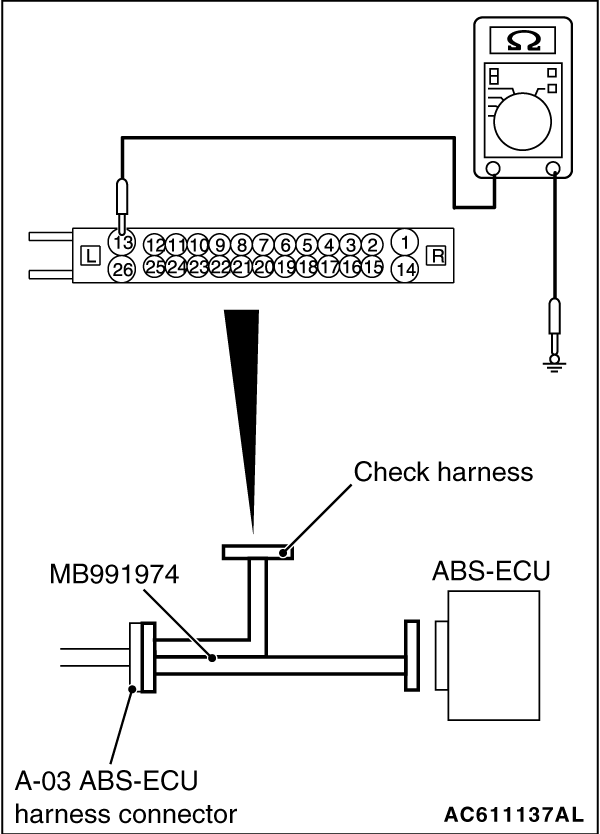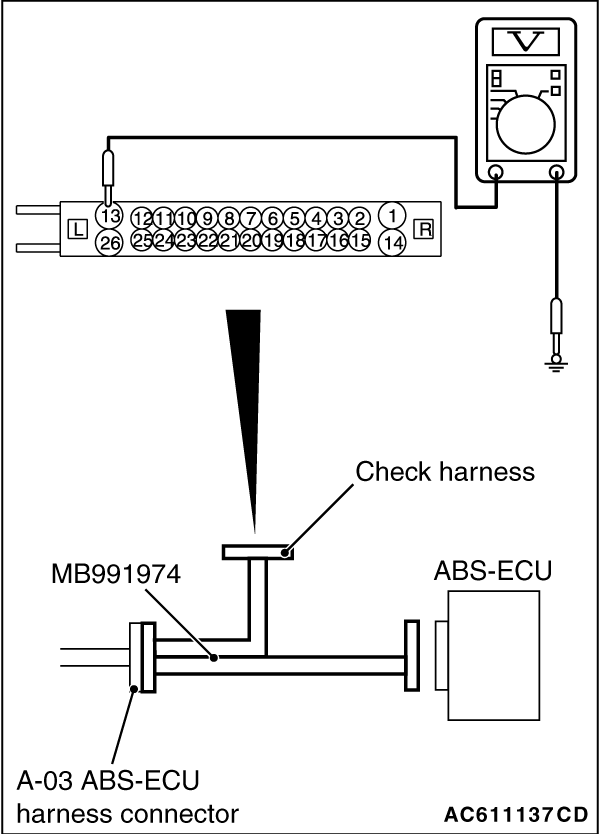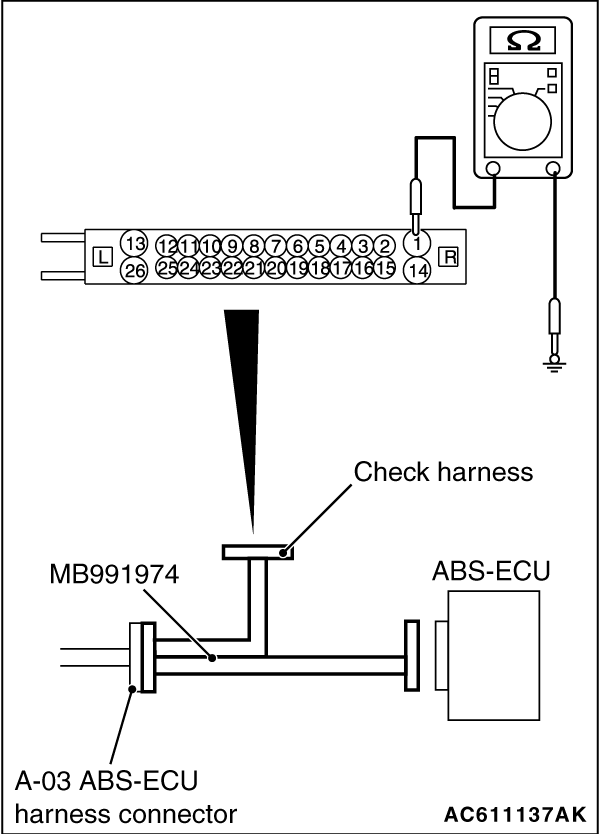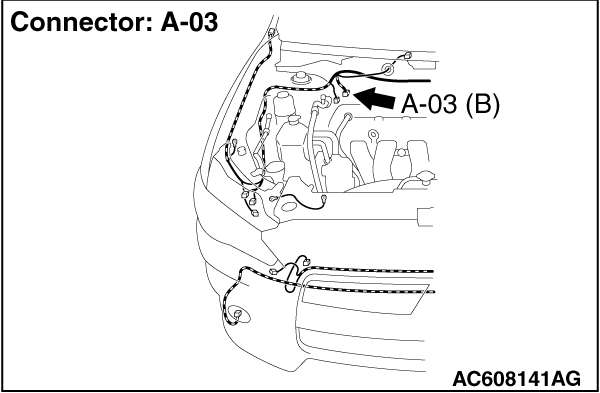|
|
- ABS-ECU contains the power supply circuit (terminal No.13) for the pump motor. The pump motor is energized by the motor switch, which is incorporated in ABS-ECU.
- The pump motor switch, which is incorporated in ABS-ECU, is always off unless the motor solenoid valve check is activated when the vehicle is started.
- ABS-ECU activates the pump motor by turning on the ECU built-in pump motor switch.
|
|
|
This DTCs will be set under the conditions below:
|
|
|
- When the power supply voltage of the pump motor, which is not in operation, is abnormally low for a prolonged period
- When the power supply voltage of the pump motor, which is not in operation, is abnormally high for a prolonged period
|
|
|
Current trouble
- Fusible link malfunction
- Damaged wiring harness and connectors
- Abnormality in battery or generator
- ABS-ECU malfunction
|
|
|
Past trouble
- Carry out diagnosis with particular emphasis on wiring harness and connector failures between the power supply circuit (A-03 ABS-ECU connector terminal No.13) to the ABS-ECU motor and the ground circuit (A-03 ABS-ECU connector terminal No.1). For diagnosis procedures, refer to How to treat past trouble (Refer to GROUP 00 - How to Cope with Intermittent Malfunction
 ). ).
|
|
|
Required Special Tools:
- MB991958: Scan Tool (M.U.T.-III Sub Assembly)
- MB991824: Vehicle Communication Interface (V.C.I.)
- MB991827: M.U.T.-III USB Cable
- MB991910: M.U.T.-III Main Harness A
- MB991974: ABS check harness
|
|
|
Use scan tool to diagnose the CAN bus lines.
|
|
|
Q.
Is the check result normal?
|
|
|
 Repair the CAN bus lines (Refer to GROUP 54C - CAN Bus Diagnostics table Repair the CAN bus lines (Refer to GROUP 54C - CAN Bus Diagnostics table  ). On completion, go to Step 2. ). On completion, go to Step 2.
|
|
|
|
|
|
 The procedure is complete. The procedure is complete.
|
|
|
|
|
|
Refer to GROUP 54A - Battery Test  . .
|
|
|
Q.
Is the battery in good condition?
|
|
|
 Replace the battery. Then go to Step 11. Replace the battery. Then go to Step 11.
|
|
|
|
|
|
Refer to GROUP 16 - Output Current Test  . .
|
|
|
Q.
Is the charging system in good condition?
|
|
|
 Repair or replace the charging system component(s). Then go to Step 11. Repair or replace the charging system component(s). Then go to Step 11.
|
|
|
|
|
|
Q.
Is the check result normal?
|
|
|
NO  : Repair the defective connector. Then go to Step 11. : Repair the defective connector. Then go to Step 11.
|
|
|
|
|
|
Visually check for open circuit in the fusible link No.26.
|
|
|
Q.
Is the check result normal?
|

|
(1)Disconnect the ABS-ECU connector, connect special tool ABS check harness (MB991974) to the harness-side connector, and measure the voltage at the special tool connector side.
| note |
Do not connect the special tool to ABS-ECU.
|
(2)Disconnect the fusible link No.26.
(3)Measure the resistance between terminal No.13 and body ground.
OK: No continuity
Q.
Is the check result normal?
 Replace the fusible link No.26. Then go to Step 11. Replace the fusible link No.26. Then go to Step 11.
 The short circuit may be present in the power supply circuit. Repair the wiring harness between the A-03 ABS-ECU connector terminal No.13 and the fusible link No.26, and then replace the fusible link No.26. Then go to Step 11. The short circuit may be present in the power supply circuit. Repair the wiring harness between the A-03 ABS-ECU connector terminal No.13 and the fusible link No.26, and then replace the fusible link No.26. Then go to Step 11.
|

|
(1)Disconnect the ABS-ECU connector, connect special tool ABS check harness (MB991974) to the harness-side connector, and then measure the voltage at the special tool connector side.
| note |
Do not connect the special tool to ABS-ECU.
|
(2)Measure the voltage between the terminal No.13 and the body ground.
OK: Approximately battery voltage
Q.
Is the check result normal?
 Go to Step 9. Go to Step 9.
 The open circuit may be present in the power supply circuit. Repair the wiring harness between the A-03 ABS-ECU connector terminal No.13 and the fusible link No.26. Then go to Step 11. The open circuit may be present in the power supply circuit. Repair the wiring harness between the A-03 ABS-ECU connector terminal No.13 and the fusible link No.26. Then go to Step 11.
|

|
(1)Disconnect the ABS-ECU connector, connect special tool ABS check harness (MB991974) to the harness-side connector, and then measure the resistance at the special tool connector side.
| note |
Do not connect the special tool to ABS-ECU.
|
(2)Measure the resistance between terminal No.1 and body ground, and between terminal No.14 and body ground.
OK: Continuity exists (2 Ω or less)
Q.
Is the check result normal?
 Go to Step 10. Go to Step 10.
 An open circuit may be present in the ground circuit. Repair the wiring harness between the A-03 ABS-ECU connector terminal No.1 and the body ground, and between the A-03 ABS-ECU connector terminal No.14 and the body ground. Then go to Step 11. An open circuit may be present in the ground circuit. Repair the wiring harness between the A-03 ABS-ECU connector terminal No.1 and the body ground, and between the A-03 ABS-ECU connector terminal No.14 and the body ground. Then go to Step 11.
|
|
|
(2)Drive the vehicle at 12 mph (20 km/h) or more.
| note |
The ABS warning light does not turn OFF in some cases unless the vehicle runs at 12 mph (20 km/h) or higher.
|
|
|
|
 Replace the hydraulic unit (ABS-ECU) (Refer to Replace the hydraulic unit (ABS-ECU) (Refer to  ). Then go to Step 11. ). Then go to Step 11.
|
|
|
|
|
|
 Intermittent malfunction (Refer to GROUP 00 - How to Cope with Intermittent Malfunction Intermittent malfunction (Refer to GROUP 00 - How to Cope with Intermittent Malfunction  ). ).
|
|
|
|
|
|
(2)Drive the vehicle at 12 mph (20 km/h) or more.
| note |
The ABS warning light does not turn OFF in some cases unless the vehicle runs at 12 mph (20 km/h) or higher.
|
|
|
|
 The procedure is complete. The procedure is complete.
|
|
|
|
![[Previous]](../../../buttons/fprev.png)
![[Next]](../../../buttons/fnext.png)


 Go to Step 3.
Go to Step 3. Repair the CAN bus lines (Refer to GROUP 54C - CAN Bus Diagnostics table
Repair the CAN bus lines (Refer to GROUP 54C - CAN Bus Diagnostics table  ). On completion, go to Step 2.
). On completion, go to Step 2. Go to Step 3.
Go to Step 3. The procedure is complete.
The procedure is complete. .
. Go to Step 4.
Go to Step 4. Replace the battery. Then go to Step 11.
Replace the battery. Then go to Step 11. .
. Go to Step 5.
Go to Step 5. Repair or replace the charging system component(s). Then go to Step 11.
Repair or replace the charging system component(s). Then go to Step 11. Go to Step 6.
Go to Step 6. : Repair the defective connector. Then go to Step 11.
: Repair the defective connector. Then go to Step 11. Go to Step 8.
Go to Step 8. Go to Step 7.
Go to Step 7.
 Go to Step 9.
Go to Step 9. The open circuit may be present in the power supply circuit. Repair the wiring harness between the A-03 ABS-ECU connector terminal No.13 and the fusible link No.26. Then go to Step 11.
The open circuit may be present in the power supply circuit. Repair the wiring harness between the A-03 ABS-ECU connector terminal No.13 and the fusible link No.26. Then go to Step 11.
 Go to Step 10.
Go to Step 10. An open circuit may be present in the ground circuit. Repair the wiring harness between the A-03 ABS-ECU connector terminal No.1 and the body ground, and between the A-03 ABS-ECU connector terminal No.14 and the body ground. Then go to Step 11.
An open circuit may be present in the ground circuit. Repair the wiring harness between the A-03 ABS-ECU connector terminal No.1 and the body ground, and between the A-03 ABS-ECU connector terminal No.14 and the body ground. Then go to Step 11. Replace the hydraulic unit (ABS-ECU) (Refer to
Replace the hydraulic unit (ABS-ECU) (Refer to  ). Then go to Step 11.
). Then go to Step 11. Intermittent malfunction (Refer to GROUP 00 - How to Cope with Intermittent Malfunction
Intermittent malfunction (Refer to GROUP 00 - How to Cope with Intermittent Malfunction  ).
). Return to Step 1.
Return to Step 1. The procedure is complete.
The procedure is complete.